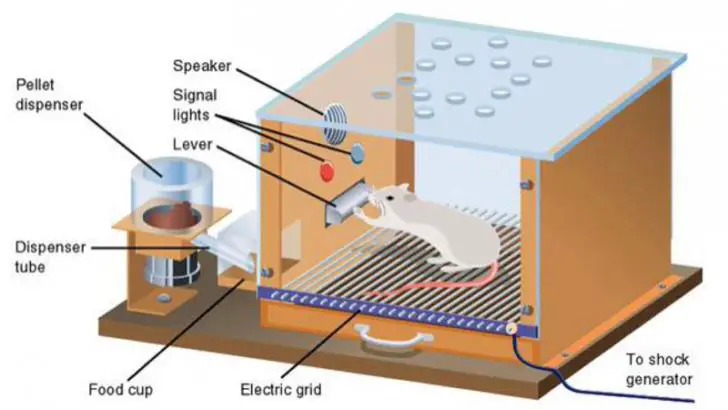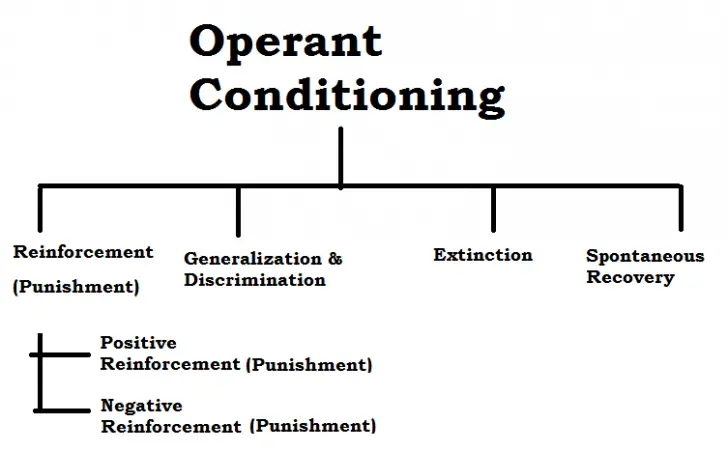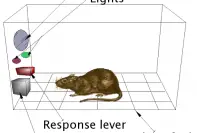Operant conditioning can be defined as a form of learning in which behaviors are dependent on, or controlled by its rewards and consequences. The study of operant conditioning helps to understand relations between a behavior and the consequence it offers. For instance, in the experiment conducted by B.F. Skinner, pressing the lever is the operant behavior that releases food as a consequence.
Since the theory was first coined by the renowned behaviorist B.F. Skinner, operant conditioning is also occasionally called Skinnerian conditioning. The behaviorist coined the behavior based on his opinion that studying the internal thoughts and motivations isn’t exactly a must in order to explain behavior. His insistence to study the external causes and consequences of human behavior gave birth to the new theory of Operant Conditioning Learning.

Skinner used the term Operant as a reference to “any active behavior that operates upon the environment to generate consequences” (1953). To put it in more general terms, Skinner’s theory dealt with the explanation of range of behaviors learned in our daily life. Skinner’s theory about conditioning learning was heavily influenced by the work of psychologist Edward Thorndike. Thorndike’s Law of Effect suggested that any action that is followed by positive outcomes or rewards are more likely to be repeated and the actions followed by negative outcomes or rewards bit less so.
Based on Thorndike’s theory, the definition of Operant conditioning thus introduced simply states that
Any action that has been followed by reinforcement (whether positive or negative) will be strengthened and it is highly likely that the particular action will be repeated again in the future.
For instance, a child is more likely to study properly, if he/she is offered some sort of reward (say a new gadget) upon receiving good marks.
Conversely, a fear of punishment can also motivate the child to study more seriously.
Concepts of Operant Conditioning

Reinforcement
The operation of administrating a reinforcer by the experimenter is called reinforcement. It’s the most fundamental and first step to operant conditioning learning. Reinforcers act as stimuli to increase the rate or probability of the responses that follow. After numerous experiments conducted by various psychologists and behaviorists throughout the history, it has been evident that reinforced responses increase in rate while the non-reinforced responses decrease in rate.
Positive and Negative are two kinds of reinforcers, both of which increase the frequency of an operant. Food and approval are two positive reinforcers, and pain, anxiety, disapproval are among few of the negative reinforcers. The reinforcers that affect the rate of operant can be either primary reinforcer or secondary reinforce.
Primary Reinforcer is directly related to organism’s survival. Eg: food, water, warmth, pain etc.
Secondary Reinforcer includes characteristics acquired with experience from the environment, such as; praise, grades, and money.
Punishment
Punishment is completely opposite to reinforcement. In contrast to the previous concept, punishment refers to the phenomenon wherein a stimulus is presented to the organism after a certain behavior has been responded. Punishment decreases the rate of the same behavior being repeated again.
Positive and Negative are two kinds of punishments, both of which decreases the frequency of an operant,
Positive Punishment can be understood as the addition of something, which causes the decrease in the rate of same behavior being repeated. For example: A kid being spanked for bullying.
Negative Punishment on the other hand is the removal of certain favorable thing from the organism’s life, which then causes decrease in the frequency of operant. For Example: Reduction in allowance of a teenager for failing in school.
Extinction
The concept which explains the disappearance of a learned response due to the removal of reinforcement from the situation is called extinction. This concept of extinction in operant conditioning learning is similar to that of classical conditioning. For example; in Skinner’s experiment, the rat might stop pressing the lever if food serving is stopped.
Generalization and Discrimination
The phenomenon where an organism depicts a similar response when reacted to similar stimuli is known as generalization.
The concept complimentary with generalization is discrimination, which explains the similar response depicted by an organism due to difference in stimuli.
Spontaneous Recovery
The concept that explains how the rat in the Skinner box automatically goes to press the lever even after being removed from the box for a certain time and the behavior is extinguished, is called spontaneous recovery.




